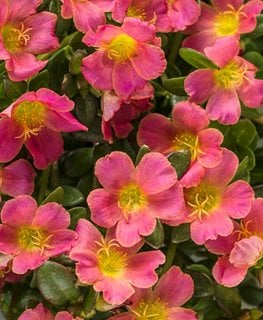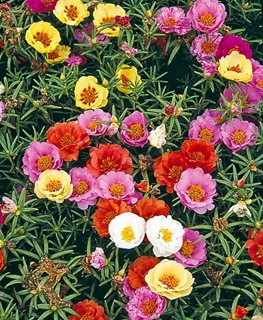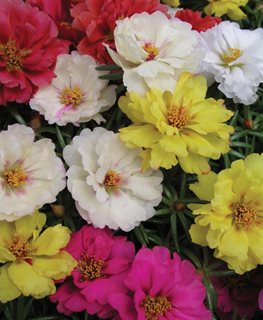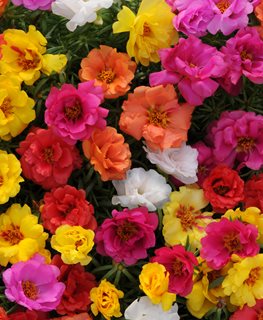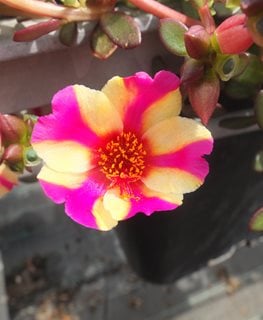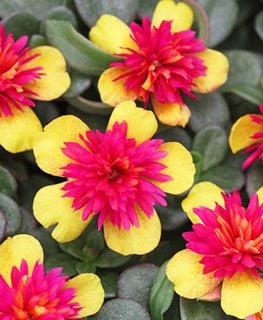PORTULACA - GROWING MOSS ROSE PLANTS IN YOUR GARDEN
Add summer sizzle to the landscape with this carefree plant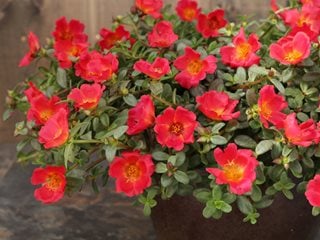
Mojave® Red purslane (Portulaca umbraticola). Photo: Proven Winners
With the growing popularity of succulents in recent years, portulaca deserves a place in the landscape. The cheerful flowers on this sun lover come in an array of pastel and vibrant tropical hues, offering weeks of continuous bloom from summer to frost. Heat and drought-tolerant, this virtually carefree plant thrives in high heat and low humidity conditions.
Ornamental portulacas are closely related to common purslane (Portulaca oleracea), an edible weed. They are useful in areas with poor soil where other plants struggle to grow, and is versatile as a ground cover, bedding plant, in containers or hanging baskets. This fast grower can be used to quickly fill in bare spots, and is attractive to bees and butterflies. (See more flowers for bees.)
On this page: Basics | Planting | Care | Choosing the Right Portulaca | Pictures | Landscaping Tips
- BASICS
- PLANTING PORTULACA
- PORTULACA CARE
- HOW TO CHOOSE THE RIGHT PORTULACA
- PORTULACA VARIETIES
- LANDSCAPING TIPS
BASICS
Common names:
Moss rose, Mexican rose, rock rose, sun rose, and purslane.
Zones:
Most are grown as annuals; P. umbraticola is hardy in Zones 10-11
Height/Spread:
Low spreading or trailing habit, 3 to 12 inches tall and 6 to 24 inches wide.
Exposure:
Plants need at least 6 to 8 hours of direct sun. Flowers won’t open in low light conditions.
Bloom time:
Summer to frost.
Flowers:
Grown for its rose-like flowers in bright or pastel hues of white, pink, red, yellow, orange, purple or bicolored. Portulaca flowers are single or double, with rounded or ruffly petals. The blooms close at night and remain closed on overcast days.
Foliage:
A trailing, dense ground cover with fleshy leaves up to 1 inch long that occur singularly along brittle red or green stems. Ornamental forms of purslane (P. oleracea) have flat paddle-like leaves, while the leaves of moss rose (P. grandiflora) are more pointed and needle-like. Wingpod purslane (P. umbraticola), which is often confused with P. oleracea, has smaller wider leaves and brightly colored flowers.
Toxicity:
Portulaca plants contain soluble calcium oxalates, which are toxic to dogs and cats.PLANTING PORTULACA
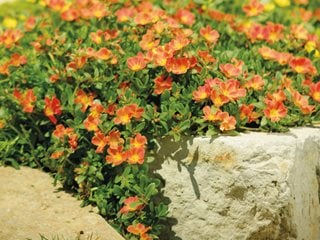
Mojave® Tangerine purslane. Photo: Proven Winners
When to plant:
Plant in late spring after all danger of frost is past.
Where to plant:
Grow in a spot that receives at least 6 to 8 hours of direct sunlight in a container or the landscape. Tolerance of sandy soil and salt makes portulaca ideal for beachfront locations.
How to plant:
Make sure soil is loose and well-draining. Dig a hole just wide and deep enough for the root ball and place plants 6 to 12 inches apart. Take care not to disturb the roots. Tamp down soil gently around the base of plants and water moderately.
Growing from seed:
Sow seeds indoors 6 to 8 weeks before your last frost-free date. Plant in individual cells or biodegradable peat pots to avoid disturbing the roots during transplanting. Use a sterile seed starting mix and gently press seeds into the soil medium. Don’t cover, as seeds need light to germinate. Keep soil evenly moist until germination, in about two weeks. Air temperature should be 65 to 85 degrees F for seeds to germinate. Keep seedlings in a bright window or under grow lights.
After all danger of frost is past, slowly acclimate plants to outdoor conditions before transplanting into the garden. Space 6 to 12 inches apart. Seeds can be directly sown outdoors when soil temperature reaches 65 degrees F.
Some varieties self-sow from year to year, but do not always come true from seed.
PORTULACA CARE
Pruning and deadheading:
Flowers are self-cleaning and need little or no deadheading. Spent flowers can be removed to prevent reseeding. If plants become lanky, cut back by up to half in mid to late summer to reinvigorate. Lightly fertilize after cutting back to stimulate new growth.
Soil:
Portulaca prefers lean sandy or rocky soil that is fast-draining, with a slightly acidic pH between 5.5 and 7.0. If soil is clay, grow in containers rather than attempting to improve the native soil. For containers, use a high quality all-purpose potting mix. Add perlite to improve drainage.
Amendments & fertilizer:
Portulaca needs little to no fertilizer. At the time of planting, apply a balanced slow-release fertilizer to promote new growth. Overfertilizing can result in lush foliar growth at the expense of flowers.
Watering:
Portulaca prefers dry conditions, though will flower best with some moisture. Supplemental watering is generally only needed during a prolonged drought and should be done sparingly, as portulacas are shallow-rooted. Overwatering can cause root rot.
Diseases and pests:
When planted in the right conditions, portulaca is virtually problem-free. Possible pests include aphids, mealybugs, slugs or snails. Overwatering or excessive humidity can cause powdery mildew, root or crown rot.
Deer resistance
Portulaca is considered deer-resistant, though extreme conditions can result in deer grazing on plants they wouldn’t otherwise.
HOW TO CHOOSE THE RIGHT PORTULACA
For borders and landscapes:
Use compact mounding varieties for edging pathways, at the front of a dry border, in rock gardens, or massed in a bed.
For slopes and hillsides:
Plant spreading or trailing varieties along a bank or slope as a quick-growing groundcover.
For containers:
Use a trailing variety as a “spiller” element by itself or in combination with other plants with similar growing needs. Compact types can be used as a “filler” element in window boxes or other containers.
PORTULACA VARIETIES
PORTULACA LANDSCAPING TIPS

Mojave® Red purslane in a border. Photo: Proven Winners
There are many ways to incorporate moss rose plants into your landscape. Here’s how:
- Mass a trailing form along the edge of a rock wall and allow to spill over the side for a dramatic cascading effect.
- Plant several hanging baskets with trailing portulaca and place in a row along the front of a sunny porch for continuous color all summer long.
- Use a compact form to fill in gaps between stepping stones for a carpet of brilliant color.
- Plant in a parking strip alongside other low growing waterwise plants such as ‘Angelina’ sedum, creeping thyme, coreopsis, blue fescue, creeping phlox, and ice plant (Delosperma) for a maintenance-free curbside display.
- Hang a basket of trailing portulaca on a shepherd’s hook and place near a sunny patio or deck to enjoy the flowers up close. Move around the yard for a different look.
- Use in areas where spring bulbs are grown to cover dying bulb foliage and quickly fill in bare spots. Since portulaca needs little supplemental water, you won’t need to worry about dormant bulbs rotting from too much summer water.
- Allow to naturalize in a rock garden with spring blooming alpines such as rock cress, thrift, campanula, dianthus, and lewisia to extend color through warmer summer months.
- Scatter seeds along a slope or hillside to quickly fill in gaps between other plants.
Companion plants:
Moss rose plans combine well with other sun loving drought-tolerant plants, including catmint, lavender, sedums, agave, ice plant, creeping thyme, dusty miller, agastache, penstemon, and ornamental grasses.
Portulaca alternatives:
Ice plant (Delosperma) has similar cultural needs, with look-alike foliage and flowers that also open during the day and close at night.
RELATED:
21 Low-Maintenance Plants
Annual Flowers
20 Drought-Tolerant Plants
24 Purple Flowers to Brighten Your Garden
Planting Ideas

